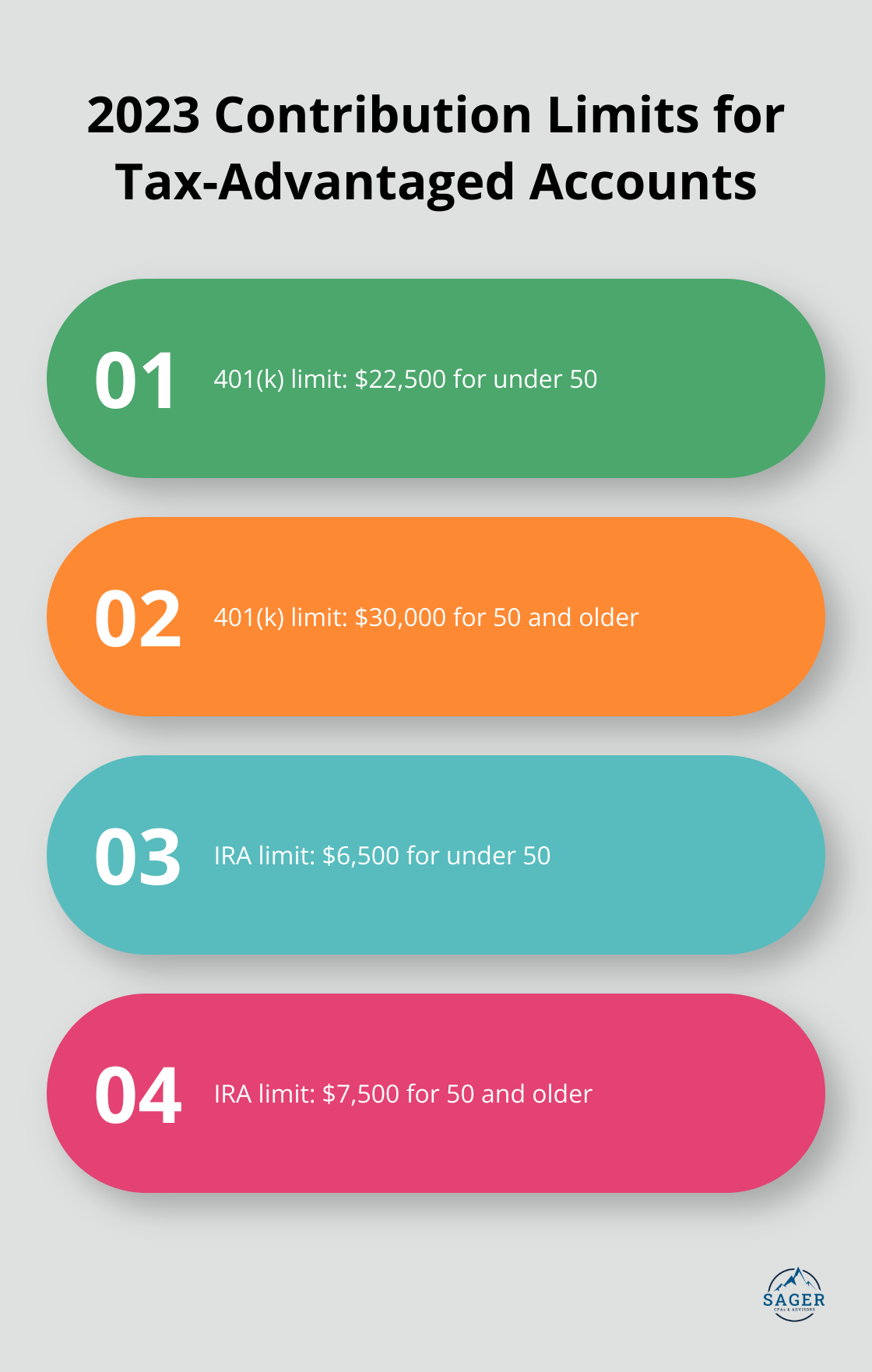
Investing tax strategies can make or break your financial future. At Sager CPA, we’ve seen how smart tax planning can significantly boost investment returns.
This blog post will guide you through essential techniques to optimize your investments while minimizing your tax burden. We’ll explore everything from basic concepts to advanced strategies, helping you make informed decisions about your financial future.
Tax-efficient investing maximizes after-tax returns by minimizing the tax impact on your investment portfolio. This approach can significantly boost wealth over time. By shying away from stocks over the long term, investors will likely earn lower returns and be less likely to outpace inflation if they concentrate their investments in more conservative assets.
Different investments carry distinct tax consequences. Stocks often offer more favorable tax treatment than bonds. In 2023, qualified dividends face taxation at 0%, 15%, or 20% (depending on income bracket). Bond interest, however, typically incurs taxation as ordinary income, which can reach up to 37% for high earners.
A key component of tax-efficient investing involves strategic asset placement. Asset location is a tax-minimization strategy that helps investors optimize their portfolio by considering the tax treatment of different types of investments. For instance, high-yield bonds often benefit from placement in tax-advantaged accounts (like IRAs). Conversely, low-turnover stock index funds may perform better in taxable accounts.
Investment turnover (the frequency of buying and selling assets within a fund) significantly affects your tax bill. Morningstar reports that actively managed U.S. stock funds have an average turnover ratio of about 63%. High turnover can lead to more frequent capital gains distributions, potentially increasing tax liability. Opting for low-turnover funds or ETFs can help mitigate this issue.

When selecting funds, consider their tax efficiency. Index funds and ETFs often provide better tax efficiency than actively managed funds due to lower turnover. Some mutual fund companies also offer tax-managed funds, which employ strategies to minimize taxable distributions.
As we move forward, we’ll explore specific strategies to implement these tax-efficient investing principles. The next section will detail key tax strategies that investors can use to optimize their portfolios and minimize their tax burden.
One of the most effective ways to reduce your tax bill involves maximizing contributions to tax-advantaged accounts. In 2023, you can contribute up to $22,500 to a 401(k) if you’re under 50, and $30,000 if you’re 50 or older. For IRAs, the limits are $6,500 and $7,500, respectively.

Health Savings Accounts (HSAs) offer a triple tax advantage: tax-deductible contributions, tax-free growth, and tax-free withdrawals for qualified medical expenses. In 2023, you can contribute up to $3,850 for individual coverage or $7,750 for family coverage.
Tax-loss harvesting is a powerful strategy that involves selling investments at a loss to offset capital gains. This technique can help investors lower their taxes by selling losing investments.
For example, if you bought a stock for $10,000 and it’s now worth $8,000, you could sell it and realize a $2,000 loss. This loss can offset other capital gains or up to $3,000 of ordinary income. However, avoid the wash-sale rule by not repurchasing a substantially identical security within 30 days.
Strategic asset location can significantly boost your after-tax returns. A study by Morningstar found that proper asset location can add up to 0.75% to annual returns.

Place tax-inefficient investments (like high-yield bonds or REITs) in tax-advantaged accounts. Keep tax-efficient investments (such as low-turnover index funds or municipal bonds) in taxable accounts. This approach minimizes the tax drag on your overall portfolio.
When selecting funds, consider their tax efficiency. Index funds and ETFs often provide better tax efficiency than actively managed funds due to lower turnover. Some mutual fund companies also offer tax-managed funds, which employ strategies to minimize taxable distributions.
Charitable giving can provide significant tax benefits while supporting causes you care about. Consider donating appreciated securities instead of cash. This strategy allows you to avoid capital gains taxes on the appreciation and still claim a deduction for the full market value of the securities.
These strategies can significantly reduce your tax burden, but they require careful planning and execution. Professional guidance can help you navigate these complex waters and create a personalized tax strategy that aligns with your financial goals. The next section will explore advanced tax optimization techniques that can further enhance your investment returns.
Roth conversion ladders offer a powerful method to minimize taxes in retirement. This strategy involves the systematic conversion of traditional IRA funds to Roth IRAs over several years. The process spreads out the tax burden and potentially reduces overall tax liability.
The mechanics work as follows: Each year, you convert a portion of your traditional IRA to a Roth IRA. You pay taxes on the converted amount at your current tax rate. After five years, you can withdraw the converted funds tax-free and penalty-free (even if you’re under 59½).
This strategy proves particularly effective if you anticipate a higher tax bracket in retirement. It also benefits those who want to avoid required minimum distributions (RMDs) in retirement, as Roth IRAs don’t have RMDs.
Qualified Opportunity Zones (QOZs) provide a unique way to defer capital gains taxes while investing in economically distressed communities. When you invest eligible gains into a Qualified Opportunity Fund (QOF), you can temporarily defer tax on those gains.
If you hold your QOF investment for at least 10 years, you’ll pay no capital gains taxes on any appreciation of your QOF investment. This can result in significant tax savings while also supporting economic development in these zones.
However, QOZ investments come with complexity and risks. They typically lack liquidity and may not suit all investors. A thorough understanding of the investment and its potential impact on your overall financial strategy is essential before committing.
Charitable giving can reduce your tax burden while supporting causes you care about. One effective strategy involves donating appreciated securities instead of cash. This approach allows you to avoid capital gains taxes on the appreciation while still claiming a deduction for the full market value of the securities.
For those over 70½, Qualified Charitable Distributions (QCDs) offer another tax-efficient giving option. You can transfer up to $100,000 annually from your IRA directly to a qualified charity. This transfer counts towards your required minimum distribution (RMD) but isn’t included in your taxable income.
Another strategy to consider involves bunching charitable donations. This method requires making larger donations in alternating years to exceed the standard deduction threshold. By itemizing deductions in the years you make larger donations, you maximize your tax benefits.
When selecting funds, consider their tax efficiency. Index funds and ETFs often provide better tax efficiency than actively managed funds due to lower turnover. Some mutual fund companies also offer tax-managed funds, which employ strategies to minimize taxable distributions.
These advanced strategies can significantly enhance your tax efficiency, but they require careful planning and execution. Professional guidance (such as that provided by Sager CPA) can help you navigate these complex strategies to optimize your tax situation and achieve your financial goals.
Investing tax strategies can significantly enhance wealth accumulation over time. The techniques we discussed, from maximizing tax-advantaged accounts to exploring advanced strategies, allow investors to boost their after-tax returns substantially. These approaches enable you to keep more of your hard-earned money working for you, rather than paying unnecessary taxes.
Tax-efficient investing requires expertise and ongoing attention due to changing tax laws, evolving personal circumstances, and fluctuating financial markets. What works today might not be optimal tomorrow. Professional guidance becomes invaluable in navigating this complex landscape and creating personalized financial strategies.
Sager CPA specializes in developing comprehensive plans that incorporate tax-efficient investing principles. Our team of experts can help you create a strategy that aligns with your financial goals while minimizing your tax burden. We offer proactive solutions, tailored action plans, and regular communication to ensure you make informed decisions about your investments.




Privacy Policy | Terms and Conditions | Powered by Cajabra
At Sager CPAs & Advisors, we understand that you want a partner and an advocate who will provide you with proactive solutions and ideas.
The problem is you may feel uncertain, overwhelmed, or disorganized about the future of your business or wealth accumulation.
We believe that even the most successful business owners can benefit from professional financial advice and guidance, and everyone deserves to understand their financial situation.
Understanding finances and running a successful business takes time, education, and sometimes the help of professionals. It’s okay not to know everything from the start.
This is why we are passionate about taking time with our clients year round to listen, work through solutions, and provide proactive guidance so that you feel heard, valued, and understood by a team of experts who are invested in your success.
Here’s how we do it:
Schedule a consultation today. And, in the meantime, download our free guide, “5 Conversations You Should Be Having With Your CPA” to understand how tax planning and business strategy both save and make you money.